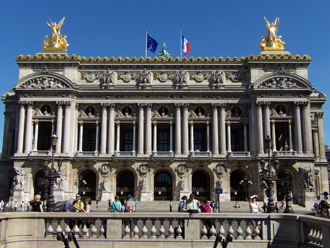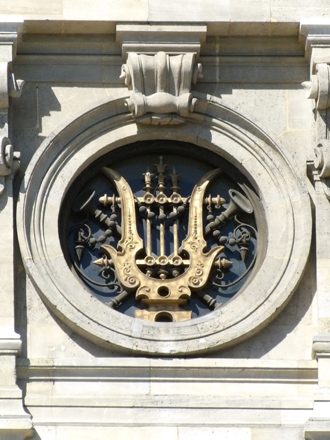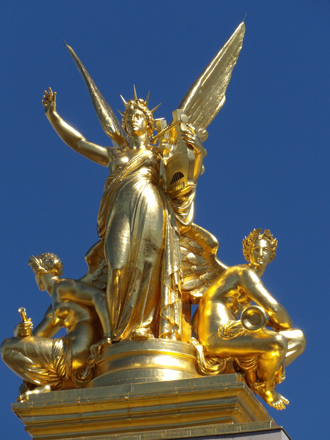|
In the mid 19th century, when Napoleon III (1808-1873) ruled France, the city of Paris was being restored and improved. As part of this, in 1861 a competition was held to choose a design for a new opera house, and the judges selected Charles Garnier’s design, so the Paris Opera House is sometimes called the Garnier Opera. It took 15 years to complete the opera building, and Napoleon III had been replaced by the Third Republic by the time the Opera opened in 1875.

The Opera is huge, covering nearly 3 acres (12,000 square meters); it is the largest opera house in the world. It contains 2,000 seats for an audience and has room for 450 performers to participate on the stage. The Opera was built above an underground water source. During construction the lowest part of the foundation was flooded, and underground water fills the lowest basement like an underground lake.

Garnier’s architectural style is considered the defining example of Second Empire style. Garnier blended classical Greek and Roman styles with a Baroque architectural spirit in his design of the Opera. Inside the building lies a colorful marble floor. Fine copper sculptures stand along walls, and massive crystal chandeliers sparkle as they hang from the ceilings. The ceilings themselves are decorated with sophisticated paintings. Seating above the main floor is arranaged in five tiers of boxes. The basic architectural design combined with the decorative details mixes impressive classic elegance with decorative extravagance, making the Opera similar to an European royal palace.

Today the Paris Opera (Palais Garnier) hosts ballet dance performances and classical music concerts, and occassionally an opera. More often, operas in Paris are performed at the Opera Bastille. Tickets can be purchased online.
The French author Gaston Leroux wrote a novel set in the Opera about the story of a genius writer with a facial deformity who lives secretly in the vast basement levels of the opera house. This story, the Phantom of the Opera, was published in serialization in 1909-1910; the story captured the imagination of readers and was adapted by filmmakers. In 1986, English composer Andrew Lloyd Webber’s musical adaptation of the story began a long run in London. Webber’s musical has been translated and performed all over the world, increasing the popularity of the opera and sparking widespread interest in Garnier’s mysterious Opera House. |
|